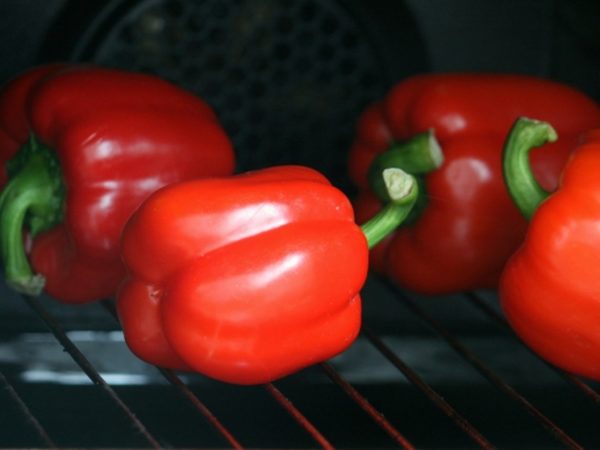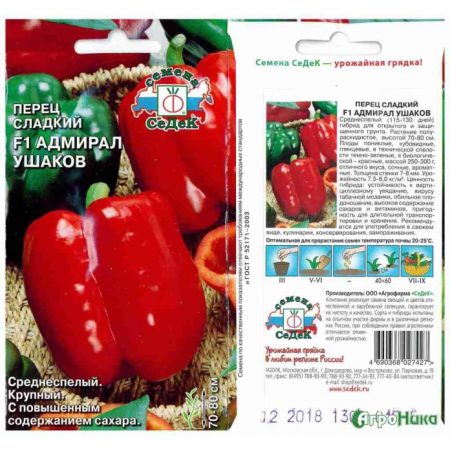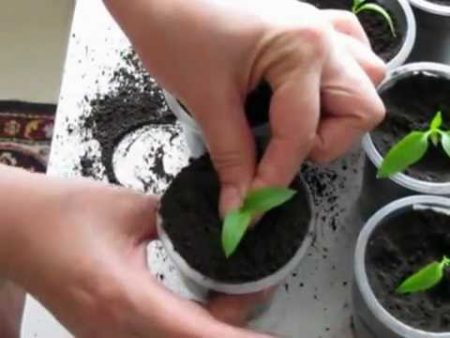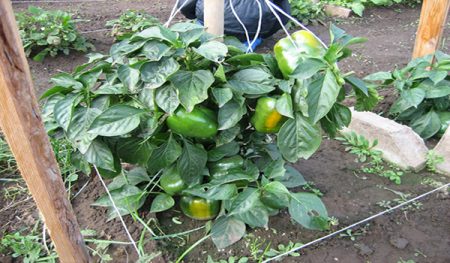 Sweet pepper culture has always been loved by gardeners. Among the huge number of seeds offered by agricultural companies, one can single out a novelty - sweet pepper “Admiral Ushakov”. Using the right agricultural technology and, given the features, its cultivation does not seem too time-consuming.
Sweet pepper culture has always been loved by gardeners. Among the huge number of seeds offered by agricultural companies, one can single out a novelty - sweet pepper “Admiral Ushakov”. Using the right agricultural technology and, given the features, its cultivation does not seem too time-consuming.
Content
Characteristic
The hybrid belongs to mid-ripening ripening groups - 113-130 days from the moment of emergence of seedlings. In technical maturity, the fruits are green, in biological - red. Designed for cultivation in open and protected ground, and are distinguished by:
- bush height - 0.5 m - 1 m;
- large, cuboid fruits weighing 170 g - 300 g;
- wall thickness 6mm - 8 mm;
- high in sugars and vitamins (sweet taste, juicy pulp);
- productivity - 7 - 8 kg from 1 m²; resistant to many diseases.
Such qualities are important: suitability for transportation, excellent storage, versatility in use.

Growing seedlings
Peppers are grown in all regions, so the timing of sowing for seedlings is different. And yet this does not mean planting - the sooner the better. To obtain strong seedlings, the optimal period is February 20 - March 20.
Seed preparation
Before planting, the seed is processed. Seeds are calibrated and discarded. Conduct disinfection treatment in solutions:
- potassium permanganate (light pink solution);
- fungicide. Soak seeds for 3 hours at a temperature of + 35 ° C. Then - thoroughly washed. The intensity of seed germination is improved by soaking for 24 hours in solutions of boric acid (5 mg per 1 liter of water) or baking soda (10 mg per 1 liter of water).
Sowing
Seeds are planted in cups with soil (you can use special mini-hotbeds, planting according to the 2x2 scheme) to a depth of 1.5 - 2 cm, a little tamped and watered from the spray gun. Then the containers are covered with a film. Sprouts appear on the 5-10th day, at insufficient temperature, germination can increase up to 20 days. It should not be sown to great depths - this can cause root decay.
Important: Use only store soil when planting. Land from the garden can be a source of disease for plants.
When the first sprouts appear, the film is immediately removed. Capacities are placed under a lighting lamp, the temperature is reduced to + 16 + 18 ° C. After 5-6 days, the temperature is increased to + 22 + 25 ° C. A thermophilic plant should not be placed on a cold window sill, drafts should be avoided.
Feeding seedlings
Peppers are fed every two weeks. The first top dressing coincides with the opening of cotyledon leaves. A mild solution of Unifor bud fertilizer is suitable (1 teaspoon in 2-3 liters of water). Top dressing is combined with watering.
Pick
A pick is carried out after the appearance of 3-4 pairs of true leaves in a plant. Pepper is very sensitive to transplantation, so we dive as carefully as possible, trying not to damage the root system.
The sprout is carefully removed from the container, and planted in a larger container.

It is important to follow the basic rules:
- the root is not shortened;
- the stem is not buried, leaving it at the same level;
- the first 2-4 days the seedlings are not highlighted.
Transplanting to the ground and leaving
Transfer
For planting Admiral Ushakov pepper, light loamy soil without stagnation of water is suitable. If the soil is depleted - make rotted humus. Under normal conditions, it is sufficient to fertilize the well when planting.
Estimated age of seedlings is 60-65 days. Seedlings are planted in warm soil (at least + 16 ° C) on a cloudy day or evening. The distance between plants is 50-60 cm, between rows - 75-80 cm. 2 tbsp. Are added to the hole. tablespoons of potash fertilizers (without phosphorus - pepper does not tolerate it), a handful of ash or eggshell and fill with water. When the water has absorbed, we proceed to the landing. Gently drop the plants out of the pot, trying not to damage the roots and, without deepening the stem, plant and condense.
Watering and feeding
Pepper is demanding on watering. Warm water is better to defend. Watering is combined with fertilizing with mineral fertilizers. Twice a season, urea is fed in a dry way (1 tbsp.spoon per 1 m²).

Bush formation
The plant is formed in two stems. Gradually tear off the leaves and remove the stepsons to the "fork". Reduce thickening, removing everything that grows inward: twigs, buds.
At the end of July, only ovaries are left on the bushes and pinch branches. This will provide a good harvest in September.
Important: pepper thermophilic plant.
He needs to irrigate with warm, settled water.
Pests and diseases
Pests
The main pests of pepper: aphids and slugs.
The fight against aphids is carried out with the help of intoxicants.
Slugs - spray soil and plants with vinegar solution (0.5 cups per bucket), Meta, Thunderstorm preparations.
Disease
The main diseases affecting pepper plants.
| Disease and symptoms | Reasons and methods of struggle |
| Stovbour - viral damage. The leaves are mosaic and fade. | The plant is dug up and burned. |
| Vertex rot - a gray spot forms on the plant, then it rots | Lack of potassium or calcium. Fertilize. |
| Stem rot - a white coating appears. |
Too thick planting, damp. Fighting excess moisture, removing diseased leaves. Dusting with ash. |
The leader in vitamin C content, universal in use, sweet pepper, is considered to be one of the most popular plants in the garden. Consistently performing agricultural practices, growing pepper “Admiral Ushakov, a rich harvest will always be provided.
But what are the characteristics fakir pepper.




 Calorie pepper stuffed with meat and rice - BZHU per 100 grams
Calorie pepper stuffed with meat and rice - BZHU per 100 grams Gorky pepper - the best varieties for open ground
Gorky pepper - the best varieties for open ground Hot pepper seeds - the best varieties for open ground and reviews
Hot pepper seeds - the best varieties for open ground and reviews Capsicum tincture for hair - how to use and reviews
Capsicum tincture for hair - how to use and reviews